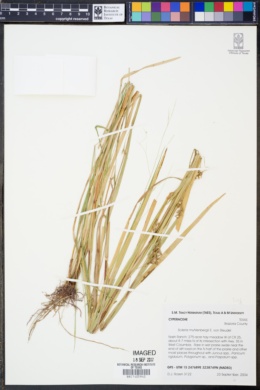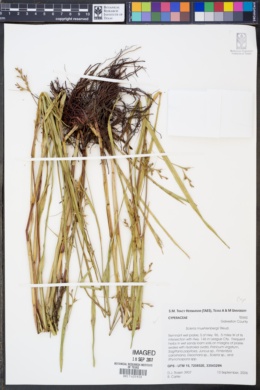|
|
|
|
Family: Cyperaceae
[Scleria reticularis var. pubescens Britton, moreScleria setacea Poir., Scleria stevensiana Britton] |
Plants annual or sometimes perennial; roots fibrous; rhizomes present in perennial forms, short. Culms solitary or in tufts, erect or spreading, slender, 20-90(-125) cm, glabrous or hairy. Leaves: sheaths often purplish tinged at base, sometimes somewhat winged, ribbed, glabrous or densely pubescent; contra-ligules rotund-obtuse, short; blades linear, flat, often ribbed, obtuse, shorter than or equaling culm, 1-5(-8) mm wide, glabrous or sparsely hirsute, sometimes scabrous on margins and veins abaxially. Inflorescences axillary and terminal, paniculate; panicles diffuse, 15-40(-80) mm, lateral clusters ± remote, the proximal pedunculate, peduncles often recurved or pendulous, filiform, compressed, (15-)20-100 mm; bracts subtending inflorescence leaflike, a bracteal leaf subtending panicles, usually 1/4-3/4 length of terminal internode, margins scabrous. Spikelets bisexual or unisexual; staminate spikelets 2-3 mm, pistillate spikelets 3-4(-5) mm; staminate scales lanceolate, pistillate scales ovate-lanceolate, acuminate. Achenes gray or brownish and/or with dark interangular lines and little pubescence, globose to ovoid, 1-3(-3.5) mm, reticulate to completely smooth, somewhat verrucose in some forms, reticulations smooth or pubescent with tufts of yellowish hairs, apex umbonate; hypogynium distinctly 3-lobed, lobes ovate-lanceolate, obtuse or subacute, sometimes cuspidate, appressed to base of achene. Fruiting summer-fall. Moist to wet (rarely dry) pinelands, savannas, prairies, and bogs: 0-500 m; Ala., Ark., Del., D.C., Fla., Ga., Ill., Ind., La., Md., Miss., Mo., N.J., N.Y., N.C., Okla., Pa., S.C., Tenn., Tex., Va.; Mexico; West Indies; Central America; n South America. Scleria muehlenbergii is uncommon inland from the Coastal Plain, occurring usually in wet places at lower elevations. This complex in Scleria is a difficult one. Recent authors recognized this plant as only a variety of S. reticularis, using the name S. reticularis var. pubescens. Taking all characters into consideration, S. muehlenbergii appears to be geographically, ecologically, and morphologically distinct from S. reticularis in the flora. As recognized here, S. muehlenbergii is quite variable in stature and achene size and sculpturing. In the United States, occasional plants occur with glabrous achenes, and some collections have achenes lacking or almost lacking sculpturing. Those variants maintain other features of S. muehlenbergii. Some tropical collections of the complex appear to be identical to United States material of S. muehlenbergii; other specimens appear somewhat different and combine characteristics in alternative ways. Those plants do not appear to be simple intermediates between S. muehlenbergii and S. reticularis. Plants from the Caribbean appear to be essentially identical to plants from the United States. Specimens of this complex from Mexico and Central America are also similar in most features to S. muehlenbergii, but some western Mexican plants are quite different, as noted by R. McVaugh (1993b), and Mexican and Central American plants usually have longer inflorescence bracts and often less pubescent achenes. More study is clearly needed here. R. McVaugh (1993b) suggested that the oldest name available at varietal rank is Scleria bracteata var. angusta Grisebach. The combination under S. reticularis appears not to have been made.
|


















